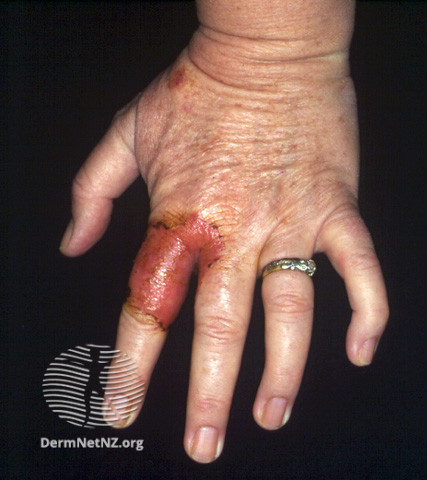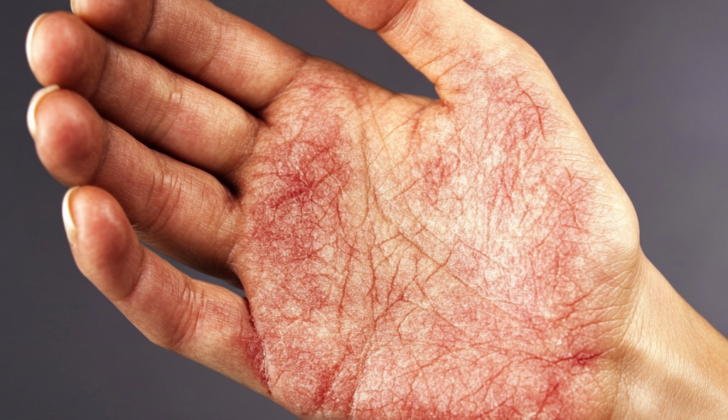What is Tinea Manuum?
Tinea manuum is a type of skin infection that affects the palms, back of the hands, or the areas between the fingers of one or both hands. This condition is generally caused by a type of fungi called dermatophytes, although it can rarely be caused by other types of organisms like Hendersonula toruloidea and Scytalidium hyalinum.
It often occurs alongside a similar infection called tinea pedis, or athlete’s foot, but sometimes it only affects the hands. Tinea manuum can be caught from anywhere around the world. Like other similar types of skin infections, tinea manuum commonly comes from direct contact with people, animals, or soil that’s been infected.
What Causes Tinea Manuum?
Tinea manuum is a skin infection caused by fungus, of which the most common type around the world is Trichophyton rubrum. However, different types of fungi can cause this infection depending on where in the world you are. These can include:
* Trichophyton mentagrophytes
* Epidermophyton floccosum
* Trichophyton verrucosum
* Trichophyton interdigitale
* Microsporum canis
Though less common, fungi such as Microsporum gypseum, Trichophyton eriotrephon, and Arhroderma benhamiae have also been linked with this infection. Recently, tinea manuum was found in patients due to a type called Trichophyton erinacei.
Several factors and conditions make it more likely for someone to get a tinea manuum infection and also a fungal infection of the nails, called onychomycosis. They include:
* Being male, having diabetes, high blood pressure, atherosclerosis, and weak immune system.
* Living in a humid environment, sweating a lot, frequent use of tight shoes, and using public bathing facilities or sports facilities.
* Scratching the bottom of the feet or picking at toenails infected with fungus.
* Working on a farm or owning certain pets like guinea pigs and hedgehogs.
* Regular hand trauma typically related to work occupations such as car mechanics, machine operators, and people who work with chemicals.
Risk Factors and Frequency for Tinea Manuum
Dermatophyte infections, a type of skin infection, are estimated to affect between 10% to 25% of the world’s population. The most common forms of these infections are tinea pedis (athlete’s foot) and tinea manuum (fungus on the hands), with athlete’s foot seen in up to 70% of adults.
While we understand a lot about athlete’s foot, not much is known about the epidemiology or spread of tinea manuum. Depending on where you live, between 0.3% to 13% of the population may be affected by tinea manuum. This condition seems to be more common in adolescent and adult males compared to other groups.
- The most frequent presentation of tinea manuum, according to one study, is the “two feet, one hand syndrome,” which accounts for 65% of cases.
- About 19.3% of cases involve both feet and both hands (bilateral tinea pedis with bilateral tinea manuum).
- Unilateral tinea manuum, which only affects one hand, makes up around 11.8% of cases.
- And about 3.9% of cases involve both hands (bilateral tinea manuum).

Signs and Symptoms of Tinea Manuum
Tinea manuum is a skin condition that affects the hands. Some people might not experience any symptoms, while others might have itchy or thickened skin. The condition usually affects only one hand, but can sometimes appear on both hands as well.
The back of the hand may show a red patch with a border of blisters and scales, and the patch might grow outward. The hand might also have multiple circular rings. The palm of the hand, on the other hand, usually appears dry and scaly.
- Red patch with blisters and scales on the back of the hand
- Multiple circular rings can be seen on the hand
- Dry and scaly appearance of the palm
There is a common variant of the condition known as the “two-foot, one-hand syndrome”, where both feet and one hand present with scaly patches or significant dryness. Some people with this syndrome also have a fungal nail infection on the affected hand or even both hands.
There’s another type of infection by fungi that live on animals that should be suspected when there are inflamed, pus or blister-filled plaques on a very red base, especially if they are located on one hand. The person might feel pain, itching, and swelling, and in rare cases, might also have an infection of the lymph vessels in the hand.
Testing for Tinea Manuum
If your doctor suspects you have tinea manuum, a type of fungal infection on the hand, they will need to confirm it with certain tests. Some experts suggest that the best way to detect this infection requires three steps: a clinical examination, a potassium hydroxide (KOH) test, and a culture test.
Various methods can be used to detect this infection:
1. Direct microscopy: This is a simple and inexpensive way to check for fungal bacteria. The doctor might swab an inflamed or wet lesion, or scrape a dry, scaly one. If there’s a chance you also may have a fungal infection in your nails (onychomycosis), they might also include nail clippings in the test. Usually, the sample will be treated with KOH and the results will come back within a day. But since its accuracy is not perfect, it should be used alongside a culture test. However, because cultures usually take 2 to 6 weeks to grow, your treatment shouldn’t be delayed while you’re waiting for the results. When possible, an additional test — antifungal susceptibility testing — should be added to the culture to determine if the fungus will respond to specific antifungal medications.
2. Fluorescent staining: This test may be used to boost the rate of fungal detection. The stain binds to the fungus’s cell wall and emits a green light under fluorescent microscope.
3. Histopathology: This procedure may be needed, especially if your doctor suspects other skin diseases could be causing your symptoms.
4. Dermoscopy: This has recently been described as a useful, noninvasive tool for diagnosing tinea manuum. It involves examining your skin using a special magnified lens.
5. Other methods: Certain advanced tests, like the polymerase chain reaction (PCR), real-time PCR, and other molecular techniques are sometimes used in large healthcare facilities and for research purposes.
Treatment Options for Tinea Manuum
There are many different types of antifungal treatments that come in cream or pill forms for tinea manuum, a fungal infection of the hand. Whenever possible, it’s recommended to use creams as they have less chance of causing side effects or interacting with other medications compared to oral treatments.
We have numerous antifungal options and they are mostly equally effective. These options include allylamines (like terbinafine and naftifine), imidazoles (like clotrimazole, fluconazole, itraconazole, and ketoconazole), and others like butenafine and ciclopirox olamine.
Treatments usually last between 4 to 6 weeks. However, some newer options, like luliconazole and econazole, can take less time, about 2 to 4 weeks.
Some antifungal creams have particular benefits. For instance, bifonazole has anti-inflammatory effects and clotrimazole and isoconazole have antibacterial properties, making them a good choice in certain situations. Nystatin is another antifungal that is effective against a type of fungus called candida, but it doesn’t work for the dermatophytes that cause tinea manuum, so it’s not recommended for this condition.
There are some cases where oral antifungal medication may be necessary. These include instances where the infection has spread to the nails or more than one body area (like “two-foot, one-hand syndrome”), when the person’s immune system is suppressed, if the infection keeps coming back, or if the creams aren’t working. The oral medications used in these cases are typically terbinafine and itraconazole, which both have similar cure rates.
The use of corticosteroids, which help to reduce inflammation, is a bit controversial. They can help with severe symptoms like itchiness or burning, and may assist some patients in adhering to the treatment. However, if corticosteroids are used, they should only be used for the first week of treatment and should be given at the same time as the antifungal therapy.
What else can Tinea Manuum be?
When trying to diagnose tinea manuum, which is a skin issue, doctors have to consider several other conditions that can cause similar symptoms. These conditions could involve different skin issues, bacterial infections, viral infections, or other fungal infections. Some of the conditions that need to be considered are:
- Psoriasis: This is often seen on both sides of the body and can result in thickened skin on the palms and soles. It can also lead to patches of unaffected skin, small fluid-filled sacs, holes in the nails, and noticeable oil spots.
- Dyshidrotic eczema: This results in small fluid-filled sacs on the edges of fingers, toes, palms, and soles. These can be very itchy and may be brought on by stress or allergies that occur during certain times of the year.
- Contact dermatitis: There are two types of contact dermatitis – irritant and allergic. Both of them can result in red and itchy skin lesions that affect the palms and backs of hands, usually on both sides. People might notice these skin lesions after coming into contact with a foreign substance like poison ivy or nickel.
- Dermatophyte infections: Inflammatory, blister-causing dermatophyte infections can be mistaken for herpetic whitlow (a type of herpes simplex infection), bacterial impetigo that also causes blisters, or cellulitis, a bacterial skin infection.
What to expect with Tinea Manuum
Getting the right diagnosis and following the appropriate treatment plan is very important to cure fungal infections properly. Sometimes, treatments could take several weeks to complete, so not sticking to the treatment plan is a common reason why the treatment might not work.
There’s always a worry that the infection could come back or reoccur after treatment. In some cases, the infections could also come from carriers who don’t have any symptoms, like family members or pets. This needs to be checked.
Additional therapies might be needed to fully manage the infection in patients who don’t respond to the initial treatment and the carriers. Methods to clean and disinfect should be used to keep the infection from spreading through touching infected objects.
Possible Complications When Diagnosed with Tinea Manuum
Most problems generally occur due to delays in seeing a doctor or getting a diagnosis for skin conditions. Sometimes, people might only get a medical check-up months or even years after they first notice the skin issue.
Other complications can include a secondary bacterial infection and inflammation of the lymphatic vessels, particularly in instances of tinea manuum – a skin infection – that originates from animals.
Sometimes, people can have allergic skin reactions from the use of topical imidazole antifungal creams, although this is rare.
In a recent case, a patient with tinea manuum and skin irritation from contact with specific substances developed difficulties in bending their fingers due to disuse.
Common Complications:
- Delayed consultations or diagnoses
- Secondary bacterial infections
- Inflammation of the lymphatic vessels
- Allergic skin reactions to antifungal creams
- Difficulty in bending fingers due to disuse
Preventing Tinea Manuum
Teaching patients about the following things is really important:
* Hand Washing: Washing your hands often can help get rid of harmful germs that are on your hands.
* Avoid Scratching: If you have a foot fungus, like onychomycosis, try not to scratch it or touch it too much.
* Preventing Tinea Pedis: This is another word for athlete’s foot, and stopping it in time can keep it from spreading to your hands.
* Check Your Contacts: If you’ve been in contact with others who might have these conditions, identifying and treating them can help stop the spread.
* Follow Your Plan: It’s really important to stick with your doctor’s treatment plan and not try to treat yourself with skin creams or antibiotics. These extra treatments that aren’t part of your plan can actually make it harder for your doctor to figure out what’s going on.












